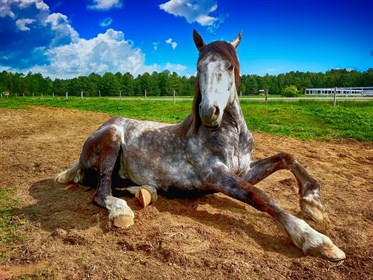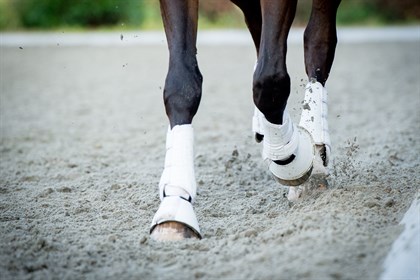
This article has appeared in a previous issue of Equestrian Life magazine. To read our free January digital issue click here.
Equine Physiotherapy
by Kate Sagar B. App. Sci. (Physio) M. Anim. St. (Physio)
THE STIFF HORSE:
Stiffness can be a huge problem for horse and rider, leading to loss of performance, training issues and secondary injury. Due to the subtle nature of stiffness and the often gradual onset of problems, our horses can become incredibly stiff without us even realising. If our horse is obviously lame or in pain we seek immediate professional advice, but more often than not we just accept stiffness, trying to work through it often without improvement.
WHAT IS STIFFNESS Stiffness can be described as a restriction to the normal amount of movement available at a particular area in the body. It may be defined in relation to what is normal for that particular horse, or it may be compared to what is normal for a horse of similar size, breed and body type. We normally think of stiffness in relation to a joint, that has lost its normal range of motion, i.e. the knee is stiff because it can no longer bend all the way to appose the forearm. However stiffness is often not that specific, but involves many joints and the muscles and other soft tissues associated with them, i.e. the hind leg can no longer track through to the hoof print of the front limb. This stiffness involves the hamstring muscles, hip, spine and spinal muscles.
WHAT CAUSES STIFFNESS A restriction in motion can be caused by a joint, a muscle or by the conformation of a local or combination of areas.
JOINT STIFFNESS Joints commonly become stiff with aging, this is a natural process which occurs gradually as the horse gets older. It can be exacerbated by the early onset of arthritis. The pain and inflammation associated with arthritis leads to changes within the joint itself, which restrict its movement. Pain leads to further joint stiffness, as the animal protects the area trying not to move it, thus reducing the pain experienced. So it becomes a catch 22 of stiffness/ pain/ more stiffness.
MUSCLE STIFFNESS Muscles also have the potential to restrict movement and lead to stiffness. Muscle tightness can occur as a result of normal training, over training or injury. Sometimes no matter how well we train our horses, there are times when muscle soreness will occur. Equally there will be times, when we are forced to over train our animals, or to face them with unaccustomed exercise. Both lead to localised pain and inflammation within the muscles, resulting in a loss of elasticity or stretch-ability of that muscle. Muscle trauma or injury can lead to a similar scenario, with the added problem of scar tissue (which occurs when a muscle heals). Scar tissue does not have the same elastic properties as muscle and can lead to huge problems. Permanent stiffness may occur following severe muscle injury, the resultant scar tissue is extremely difficult to mobilise and unless therapy is introduced early on in the healing phase, the results are usually disappointing.
CONFORMATIONAL STIFFNESS The way the body is shaped, the length of certain bones or the size and shape of joints can lead to physical restrictions to the amount of movement possible i.e. if the horse has a sway back then the amount of arching or flexion of the back will be limited. Conversely if the horse has a roached back then the amount of hollowing or extension of the back will be limited. Conformational restrictions are not necessarily a problem. Unfortunately the horse can only work with the movement potential that it has, which may in turn limit its athleticism. Often horses compensate for a lack of movement in one area with an increased flexibility in another area, resulting in a functional amount of movement.
WHAT HAPPENS IF WE IGNORE OUR STIFF HORSE? Stiff horses can remain that way, often without too much pain or discomfort, but they are not going to progress as they should and they are certainly not going to be much fun to ride! They will either remain stiff or get progressively stiffer (a no win scenario). More importantly however, is the chance of developing secondary injuries as the horse compensates for its inability. When one area is compromised, the horse will do all it can to achieve what you ask, thus over stressing the next joint or muscle complex and placing it at risk of injury. Eventually things will come unstuck as the horse struggles to cope with the increased stresses placed upon it.
WHAT CAN BE DONE FOR THE STIFF HORSE? Most of the time stiffness issues can be treated successfully. It is a matter of identifying the primary problem and getting that moving. Mobilisation techniques can be used to increase the range of movement at stiff joints and to release and stretch tight muscles. In combination with home exercises, even a horse with conformational issues can remain supple and continue training at its peak.
It’s the old saying ‘MOVE IT OR LOSE IT’ and unfortunately it’s very true!
READ THE LATEST NEWS ARTICLES HERE
https://www.equestrianlife.com.au/articles/Physiotherapy-The-stiff-horse-part-1


